The cheerful café-loving international flotsam-jetsam of Dharamsala doesn’t usually come further north to Bir, a small village in the Kangra district of Himachal Pradesh. Bir is instead home to a quiet Tibetan settlement and dotted with Buddhist monasteries. In October though, great flocks of flying strangers come from around the world to Bir. Bir is next door to Billing, one of the world’s best spots for paragliding – made miraculous by a confluence of thermals (columns of rising air). This year the Pre-World Cup Paragliding 2013 Championship was held in Bir-Billing from October 24 to October 30 after a gap of five years. Competition or no competition, every October this village looks up to skies filled with strange migratory creatures: paragliders, fulfilling the fantasies of every lunatic Da Vinci and blue-print-loving eccentric and child who hasn’t been told off for daydreaming.
Story and Photos by Garima Jain

Welcome to Billing, 2325 m above sea level and 14 km north of Bir. These green meadows have been the launch site for over 160 pilots from 33 countries who participated in this year’s competition at Bir-Billing. Over the last 15 years Bir-Billing’s excellent thermals (strong columns of air, not to be confused with warm innerwear) have attracted more and more fliers. Not all of the pilots who come to Bir in October come for the Rs 2.5 lakh prize; some were free flyers, there simply to defy gravity.
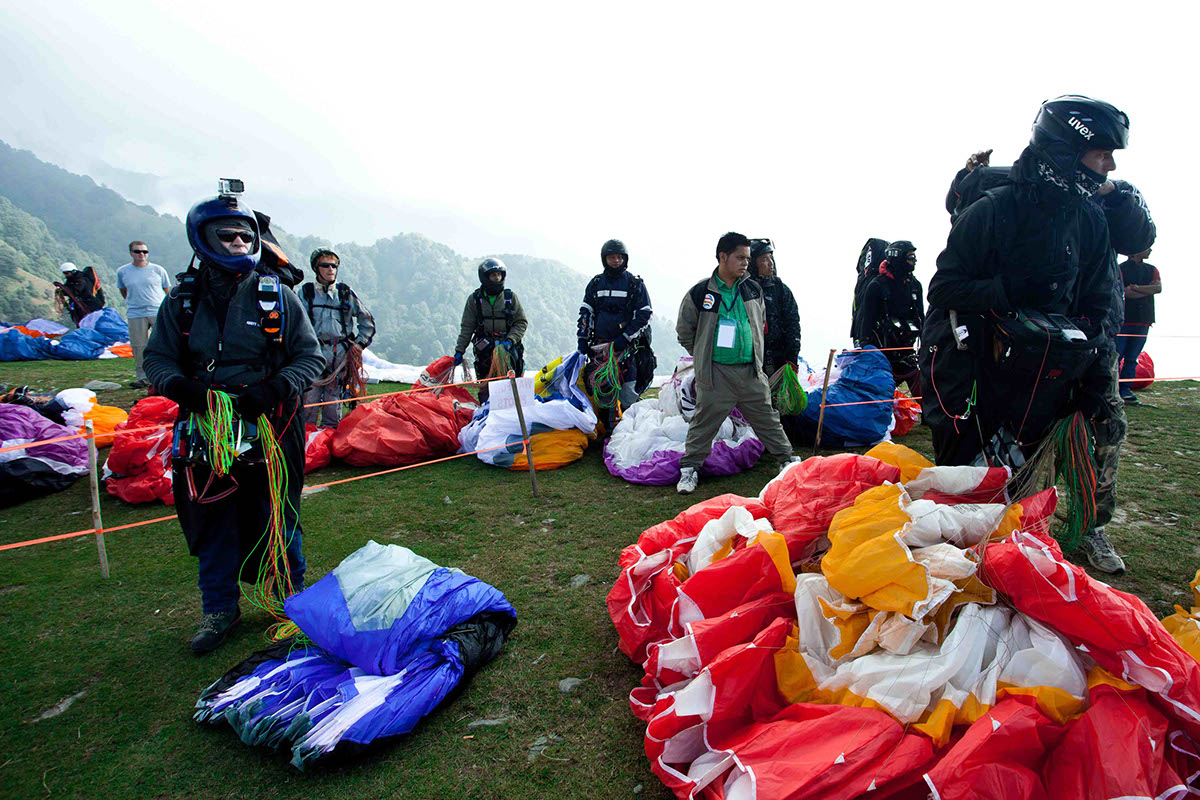
Every morning of the championship, paragliders drive up from Bir to the landing site in Billing with their gear. It is here that pilots congregate, figure out the competitive challenges for the day and scope out terrain and weather conditions. In good weather, the gliders get complex tasks that involve as much as 6 hours of non-stop flying over difficult terrain to spots decided by the judges.

At the start of the championship, the organizers held a puja to appease the weather gods. Sadly, it didn’t seem to work: flights on the first two days of the weeklong festival had to be called off because of the low clouds that crowded the valley. Regulars commented wisely that the weather this year was uncharacteristic and unpredictable.

The pageantry wasn’t all in the air. The opening ceremony at the launch site, (organized by the Himachal Pradesh state government and the Billing Paragliding Association) had this stately marching band from Nepal kitted out with drums and bagpipes.

Arvind Paul waves goodbye to his aunt and cousins. Thirty-three-year-old Paul is a local paragliding champion in Bir, who first began to paraglide while working in a garment export business in Delhi. He kept it secret from his family initially: his father would say, “I’ll buy you a car, but not a paraglider”. After buying a third-hand glider from a foreigner for Rs 55,000, he began to succeed in national championships in the last three years, taught by renowned paragliding pilot Ajay Sharma in Manali.
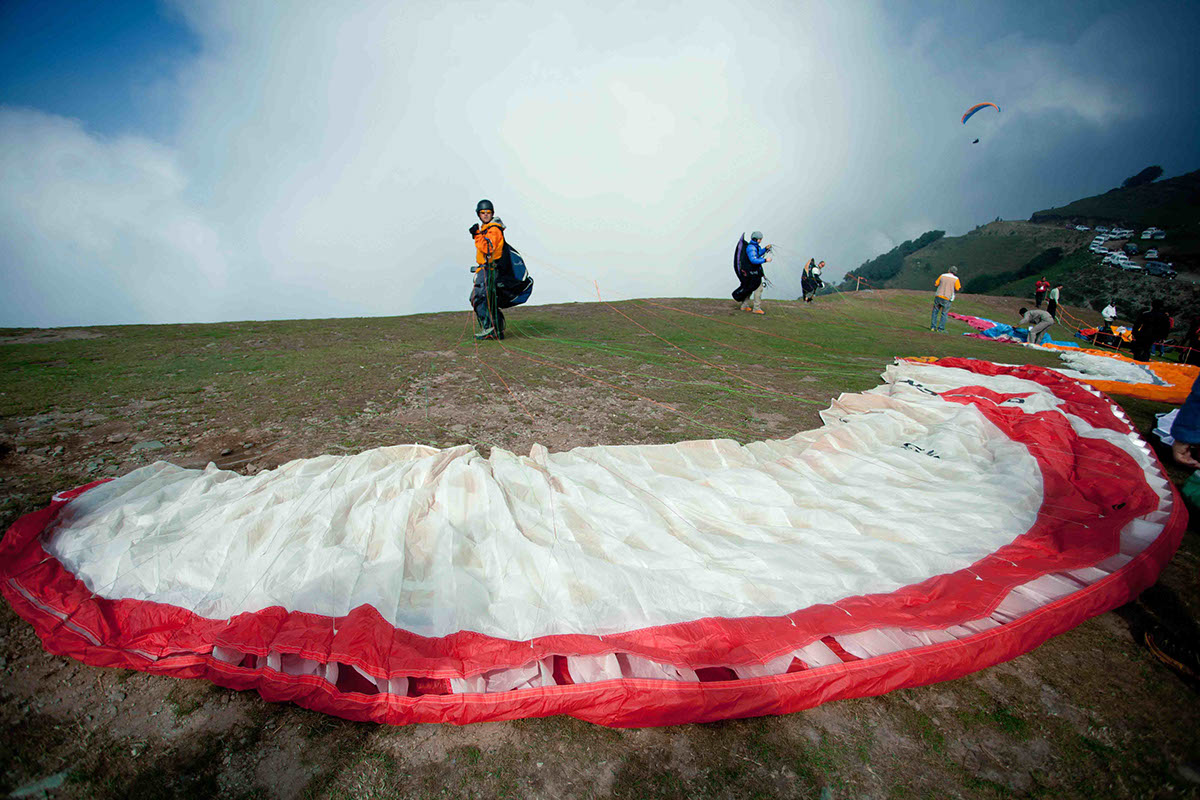
A pilot readies himself for liftoff. Organizers decide on the tasks that pilots must complete, and remain in touch with them through their flight. Pilots are tracked by devices that contain GPS, help them gauge wind speed and altitude, understand the local terrain and help them decide in which direction they should fly. Many free flyers took off from Billing during the competition.

As a flight can last several hours, pilots carry supplies with them such as food and water to keep them going through the journey; up in the sky, life can be a picnic. And should nature call mid-flight, it isn’t a big deal at all: peeing while in the air is a distinct possibility.

Being an adventure sport, paragliding is commonly thought of as physically strenuous, but there are no restrictions on age or fitness. To be able to fly has been one of mankind’s oldest dreams. Today, it takes only a week-long course and the equipment that fits neatly into a backpack for someone to learn how to paraglide.
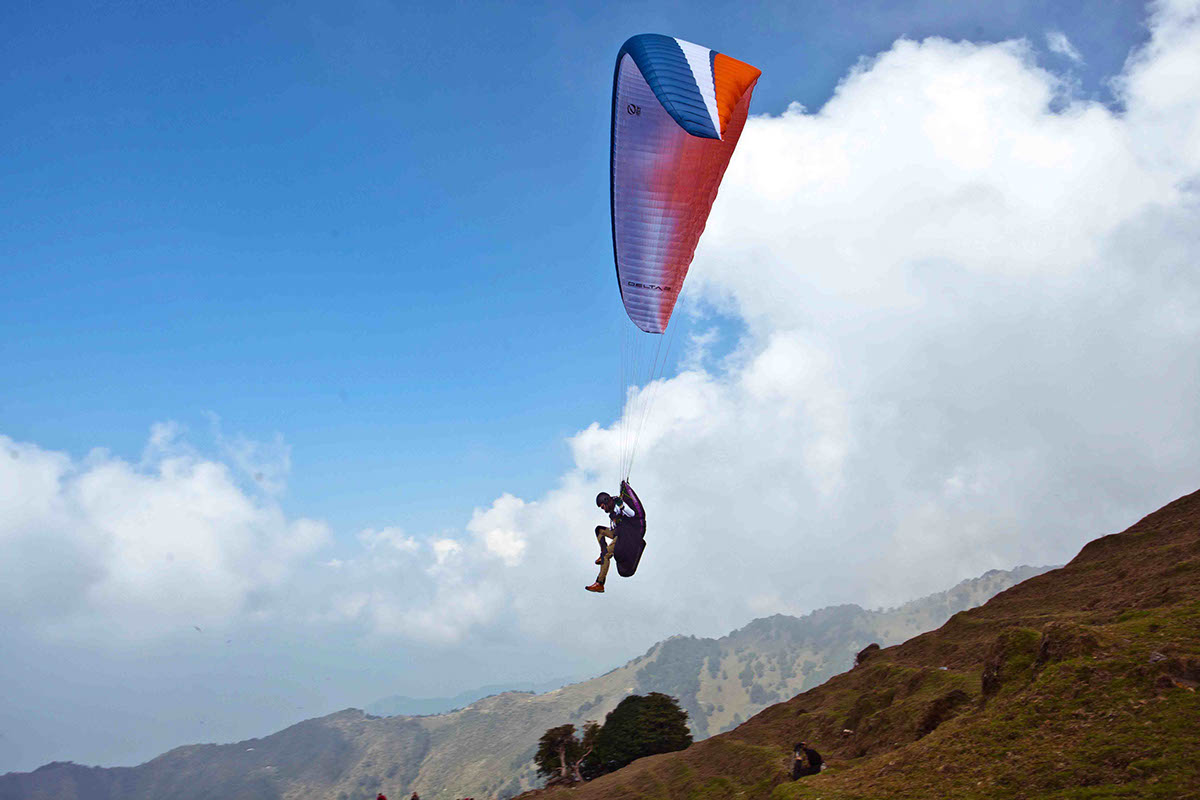
Thermals are what paragliders rely on to keep them aloft. Thermals can take a paraglider thousands of feet high, even a couple of kilometers high, especially in good weather conditions. The majority of paragliding is done much below 10,000 feet (3km). Higher altitudes are usually prohibited because you might find yourself starved for oxygen. Identifying a thermal during a flight takes luck and skill; without clouds or dust devils to indicate their presence, pilots have to rely on a vertical speed indicator called a variometer.

Distance, silence, concentration. Paragliding is an experience that cannot escape being described as spiritual. “It makes me feel connected with nature. It’s a peaceful feeling; it’s like doing meditation or yoga,” said Joel, an American paraglider. Paragliders who look down from the sky may see events as unpredictable as a dream. Instead of the usual cricket-playing boys, one paraglider said, “I floated over a gathering of thousands all being addressed by the Dalai Lama.”

Before paragliders can reach their celestial grace they sometimes have go through avatars that bear a striking resemblance to the domestic chicken

Paragliding is a cerebral sport; it involves hundreds of micro-decisions in the course of a flight, such as which direction to fly in and how to fly there. Paragliding offers moments of meditation, but it can also be deeply stressful. It is a sport that requires one to be intensely in the present, and can wear one down mentally in the course of a flight.

Human history is filled with attempts to fly that have ended in death or at best, a loss of dignity.
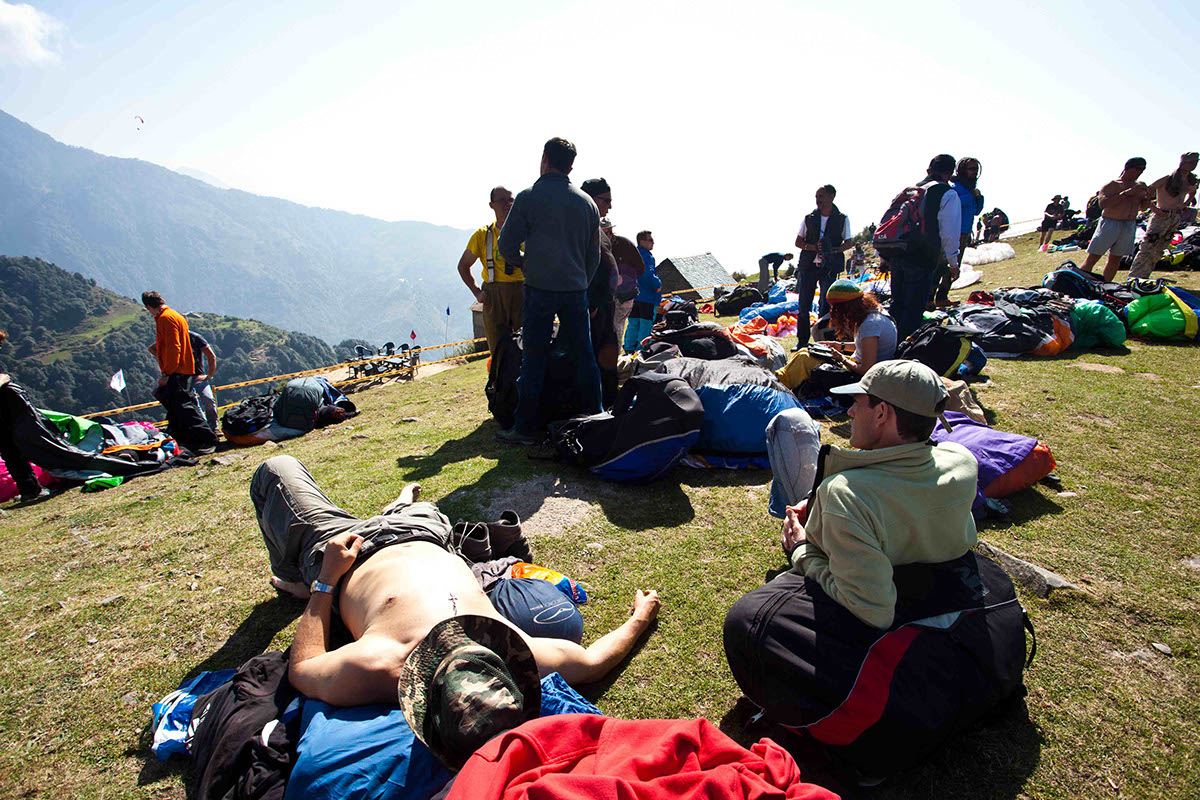
Paragliders form a friendly global community, and some paragliders from India and abroad have made Bir their home. The ‘Flying Babas’ run Camp 360 – which opened in 2005 and lies half an hour from Billing as the crow flies – where flyers can take off and land, spend the night, and have a good meal.


In Pokhara, paragliding is a common enough activity that local people are familiar with aspects of the sport; gliders say it is the only place in the world where local people at the landing site turn up to help paragliders pack their gear, all for the cost of Rs 20. In Bir, residents and tourists are not jaded enough to ignore any flying machine. People often come running up when paragliders land, to inspect the strange being that came out of the sky.

During the championship, a hot-air balloon was tethered at the landing site. In a hilarious moment, officials and a special guest meant to go on an inaugural ride couldn’t do more than hover a few feet above the ground before the mission was aborted due to severe winds. Among Bir’s oddities is a ‘The Flying Monk’, a monk from a local monastery with a penchant for paragliding.
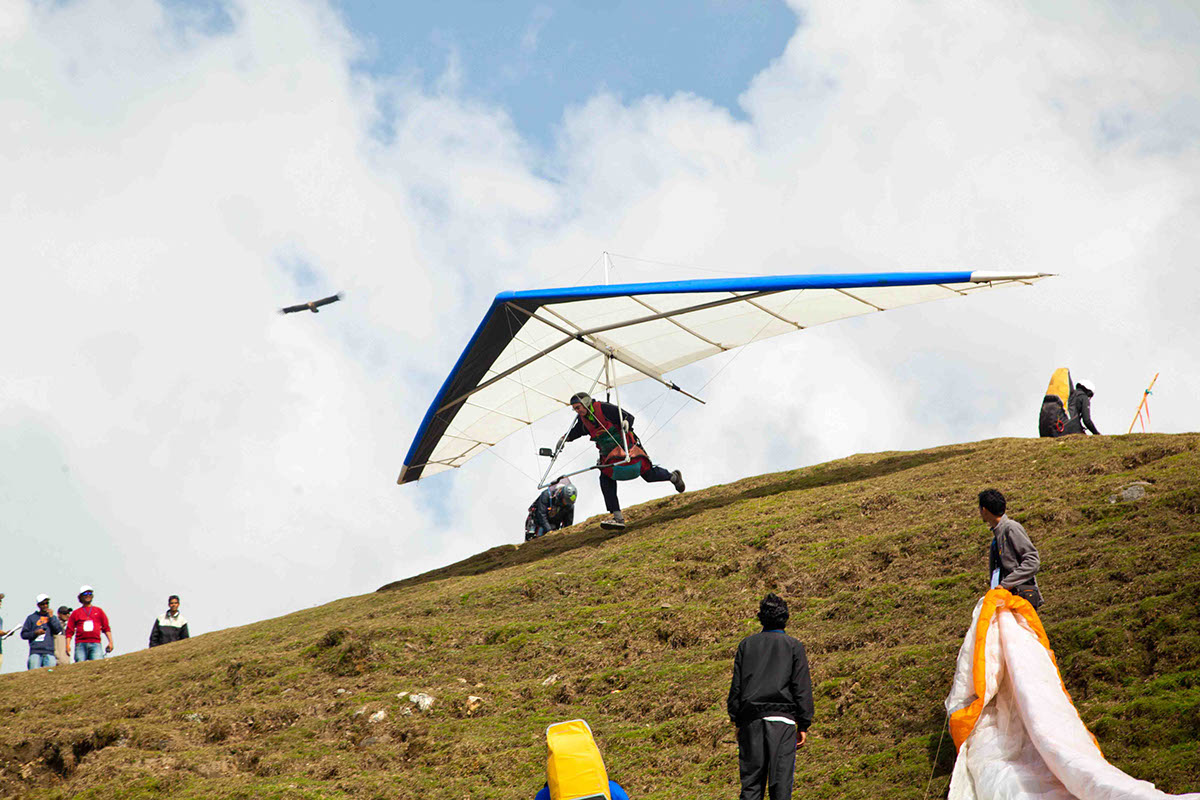
Before Bir was a paragliding hotspot, it was beloved to the now out-moded hang gliders, and held its first international hang gliding rally in 1984. At this year’s event, there was only one hang glider who had come to fly. On a morning when officials were trying to stop people from taking off because of the poor weather, the pilot of this hang glider decided that he had come too far for a few spoilsports to get in his way. Even as shouts rang in the air, cautioning him to stop, he set off at a run, determined to have his moment close to the sun.

Around the world paragliders make a little money on the side by taking folks on tandem rides. In the air, two is company and a revenue model.

Around 50 Indian pilots now call Bir home. The prohibitive cost of paragliding (a new glider can cost a couple of lakhs) means that not many Indians can afford the sport – they often buy their equipment second or third hand from foreign pilots. Another local pilot in Bir attempted to construct his own paraglider to be able to teach people in the region. A foreign visitor was so impressed with his effort that he donated his paraglider.

Schoolchildren watch a pilot approach at the landing site in Bir. At the landing site, children and spectators watch as the pilots descend into what seems like a large picnic: onlookers make themselves at home seated in chairs and under umbrellas with blaring music, and schoolboys even play football as the pilots pass overhead and land in their midst.
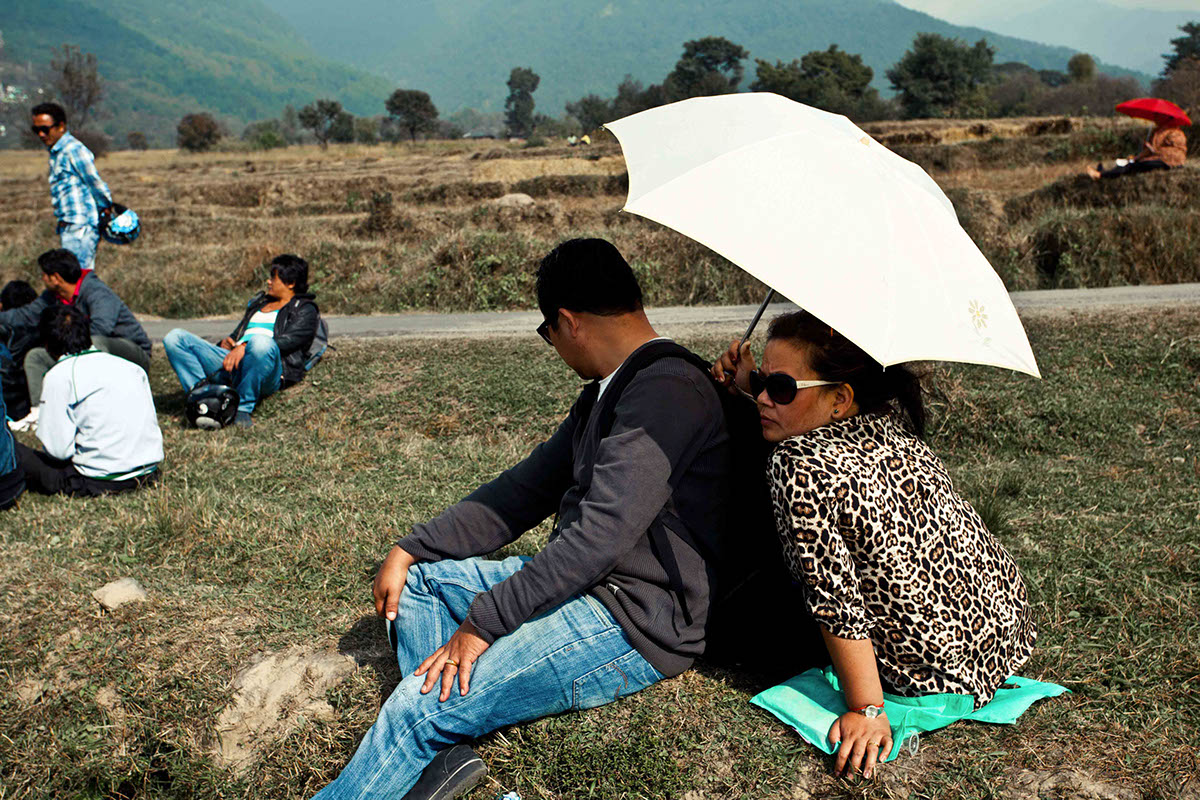
Every evening during the festival, Bir residents gather at the landing site. Watch a dreadlocked paraglider land, sip your drink, eat and lounge under an umbrella. That’s how you do it in Bir.

After a few days of watching people fly you tend to forget that sometimes they fall. Being caught in a cloud could mean disqualification in a competition, apart from being extremely dangerous. It impairs visibility, could cause mid-air collisions with fellow pilots, and can cause vertigo or leave the pilot disoriented. More alarming is the possibility of a ‘cloud suck’, which can lift a pilot hundreds of meters into the sky. A common cautionary tale is that of Ewa Wiśnierska, a German paraglider who in 2007 was trapped between passing storm cells and was sucked thousands of meters high. With the cold and lack of oxygen, she fainted, but miraculously survived the ordeal; fellow pilot He Zhonpin, who was sucked in with her, died after he was struck by lightning. Last year, two Americans died in paragliding accidents in Bir. This year, on the third day, a Russian free flying pilot crashed and injured his back and hipbone. An emergency helicopter and ambulance was on call through the festival and the Russian flier was taken swiftly to a hospital. Other paragliders looked on at these proceedings with near-Russian, fatalistic shrugs saying, “It happens.”
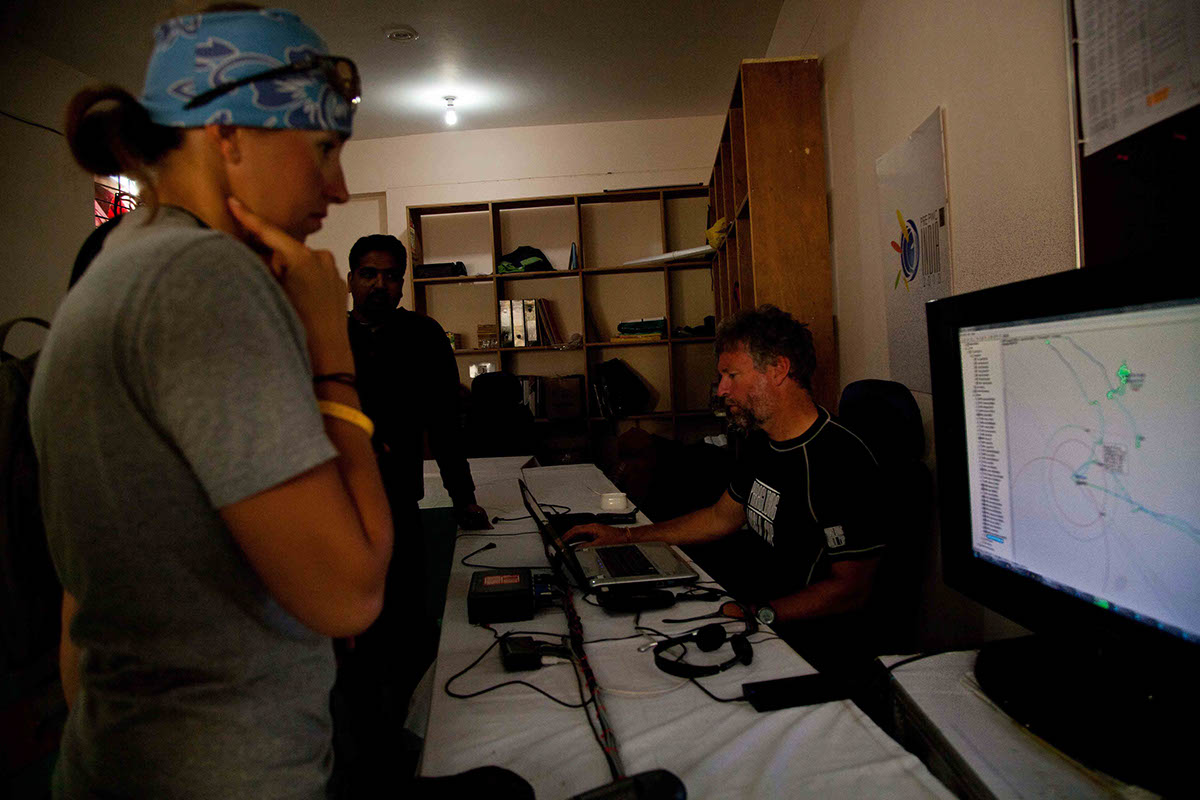
The control room in Bir, where observer Paragliding World Cup Association observer Ulric Jessop (seated) notes competitors’ performances. Once the day’s flight has ended, competitors make a beeline to the control room where they hand in their omniscient GPS devices, on the basis of which their performance is judged.

Many pilots have their pet superstitions for success, some even going to the extent of wearing a particular colour for good luck. In Bir though, many paragliders come to their hot favorite shrine – a local deity nicknamed Thermal Devi. They come to the Devi to appeal for their most fervent desire – good weather.

In the air, a bird can be a paraglider’s best friend. They indicate thermals and provide company on solitary flights. To avoid collisions or having birds get entangled in their paragliders, pilots make sounds to alert birds to their presence. This can mean that in October, birds in Bir find themselves serenaded by pilots singing to them to divert their flight path.
